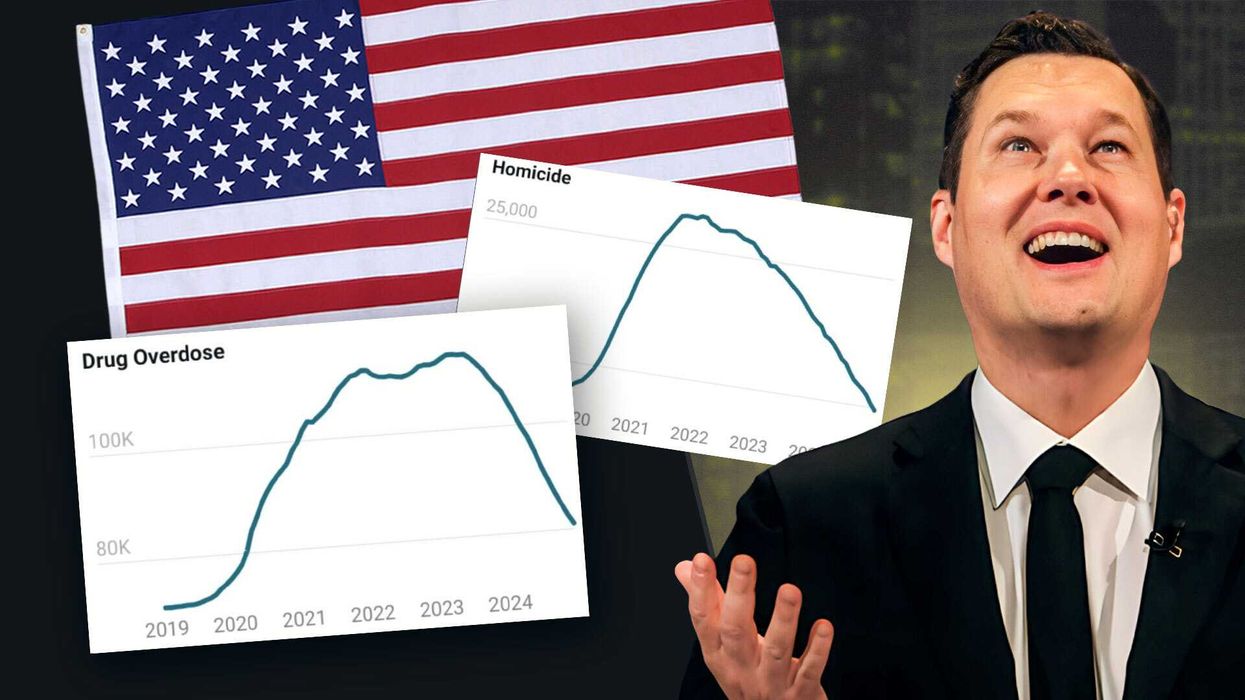
© 2025 Blaze Media LLC. All rights reserved.
Here Are the 4 Toughest Criticisms a Libertarian Think Tank Had for the Heritage Immigration Analysis
May 08, 2013
 The Heritage Foundation vs. the Cato Institute
The Heritage Foundation vs. the Cato Institute
A new study on the cost of immigration reform is being met with some serious backlash.
A report published Monday by The Heritage Foundation claims that the immigration bill currently being considered by the U.S. Senate will cost taxpayers roughly $6.3 trillion.
The conservative think tank’s trillion-dollar figure is based on the amount of benefits they estimate the feds will pay out to newly legalized immigrants minus the amount immigrants will pay back into the system.
The report claims that over the lifetime of newly legalized immigrants, the feds will pay out $9.4 trillion in benefits -- including Social Security and Medicare, Medicaid, food stamps, coverage under Obamacare, etc. -- while legalized immigrants will only pay back $3.1 trillion in taxes.
The libertarian Cato Institute was not at all impressed with Heritage's analysis and immigration policy analyst Alex Nowrasteh said so in a fairly scathing article titled, “Heritage’s Flawed Immigration Analysis.”
“It’s not the first time that I’ve questioned the free-market credentials of my friends at Heritage lately, and that’s making me sad,” Nowrasteh writes.
Here are the Cato Institute’s four biggest criticisms of the Heritage immigration analysis:
4. Milton Friedman Never Said That:
 Noted economist Milton Friedman. (Associated Press.)
Noted economist Milton Friedman. (Associated Press.)
…Jim DeMint and Robert Rector of the Heritage Foundation invoke the free-market pantheon in arguing their anti-immigration stance: “The economist Milton Friedman warned that the United States cannot have open borders and an extensive welfare state.”
They’re halfway right about that. What Friedman actually said was that immigration is “a good thing for the United States…so long as it’s illegal.”
He meant that open immigration is highly beneficial to the economy, provided those productive but inexpensive laborers do not have access to welfare. Friedman later wrote that, “There is no doubt that free and open immigration is the right policy in a libertarian state.” Friedman’s problem was with the welfare state, not immigration. His remarks are fundamentally at odds with the position Heritage is trying to argue.
3. Flawed Methodology:
 Getty Images.
Getty Images.
I criticized an earlier version of this report in 2007, arguing that their methodology was so flawed that one cannot take their report’s conclusions seriously. Unfortunately, their updated version differs little from their earlier one.[…]
The new Heritage report is still depressingly static, leading to a massive underestimation of the economic benefits of immigration and diminishing estimated tax revenue.
It explicitly refuses to consider the GDP growth and economic productivity gains from immigration reform—factors that increase native-born American incomes. An overlooked flaw is that the study doesn’t even score the specific immigration reform proposal in the Senate. Its flawed methodology and lack of relevancy to the current immigration reform proposal relegate this study to irrelevancy.
2. Heritage's Questionable "Solution"
 Getty Images.
Getty Images.
Here’s Heritage’s solution to the fiscal problem posed by immigration reform:
Because the majority of unlawful immigrants come to the U.S. for jobs, serious enforcement of the ban on hiring unlawful labor would substantially reduce the employment of unlawful aliens and encourage many to leave the U.S. Reducing the number of unlawful immigrants in the nation and limiting the future flow of unlawful immigrants would also reduce future costs to the taxpayer.
Again, Nowrasteh is unimpressed:
Professor Raul Hinojosa-Ojeda of UCLA wrote a paper for Cato last year where he employed a dynamic model called the GMig2 to study comprehensive immigration reform’s impact on the U.S. economy. He found that immigration reform would increase U.S. GDP by $1.5 trillion in the ten years after enactment.Professor Hinojosa-Ojeda then ran a simulation examining the economic impact of the policy favored by Heritage: the removal or exit of all unauthorized immigrants. The economic result would be a $2.6 trillion decrease in estimated GDP growth over the next decade. That confirms the common-sense observation that removing workers, consumers, investors, and entrepreneurs from America’s economy will make us poorer.
Would decreasing economic growth by $2.6 trillion over the next ten years have a negative impact on the fiscal condition of the U.S.? You betcha.
Do the authors consider the fiscal impact of their preferred immigration policy? Nope.
1. Parting Shots:
 Getty Images.
Getty Images.
For those of us who “grew up” on the fine policy analysis long produced by Heritage, the immigration report is a supreme disappointment.
No one has done more than Heritage to promote the importance of dynamic scoring, which is critical to understanding the true effects of government activity on the marketplace. For that organization to have seemingly abandoned its core principles for this important debate is a stinging blow to those of us who crave an honest, data-driven debate on the fiscal merits of policy.
--
Follow Becket Adams (@BecketAdams) on Twitter
Featured image Jay Westcott/POLITICO.
Want to leave a tip?
We answer to you. Help keep our content free of advertisers and big tech censorship by leaving a tip today.
Want to join the conversation?
Already a subscriber?
more stories
Sign up for the Blaze newsletter
By signing up, you agree to our Privacy Policy and Terms of Use, and agree to receive content that may sometimes include advertisements. You may opt out at any time.
Related Content
© 2025 Blaze Media LLC. All rights reserved.
Get the stories that matter most delivered directly to your inbox.
By signing up, you agree to our Privacy Policy and Terms of Use, and agree to receive content that may sometimes include advertisements. You may opt out at any time.






